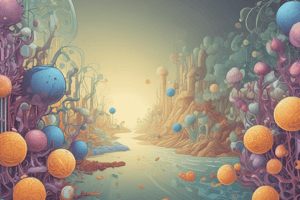Podcast
Questions and Answers
What is the typical diameter range of microorganisms?
What is the typical diameter range of microorganisms?
- 0.1-5.0 μm (correct)
- 0.01-0.1 μm
- 10.0-50.0 μm
- 5.0-10.0 μm
Which type of microorganism is characterized as single-celled eukaryotes?
Which type of microorganism is characterized as single-celled eukaryotes?
- Viruses
- Fungi
- Protozoa (correct)
- Bacteria
What is the primary role of microorganisms in ecosystems?
What is the primary role of microorganisms in ecosystems?
- Producing oxygen and carbon dioxide
- Synthesizing complex organic compounds
- Decomposition and nutrient cycling (correct)
- Regulating climate and weather patterns
How often can some microorganisms double in number?
How often can some microorganisms double in number?
What is the primary source of energy for microorganisms?
What is the primary source of energy for microorganisms?
What is the role of microorganisms in human health?
What is the role of microorganisms in human health?
What is an example of a symbiotic relationship between microorganisms?
What is an example of a symbiotic relationship between microorganisms?
What is the role of microorganisms in industrial applications?
What is the role of microorganisms in industrial applications?
What is the result of microorganisms' metabolic processes?
What is the result of microorganisms' metabolic processes?
What is the primary environment where microorganisms can be found?
What is the primary environment where microorganisms can be found?
Flashcards are hidden until you start studying
Study Notes
Definition and Types
- Microorganisms: living organisms that are too small to be seen with the naked eye, typically measuring between 0.1-5.0 μm in diameter.
- Types:
- Bacteria: single-celled prokaryotes, e.g. E. coli, Staphylococcus aureus
- Viruses: tiny particles made up of genetic material and protein, e.g. influenza, HIV
- Fungi: eukaryotes, e.g. yeast, mold
- Protozoa: single-celled eukaryotes, e.g. amoeba, paramecium
- Algae: simple aquatic plants, e.g. green algae, diatoms
Characteristics
- Microorganisms are incredibly diverse, with different species adapted to various environments
- Most microorganisms are harmless to humans, and many are beneficial
- Microorganisms can be found almost everywhere, from extreme environments to the human body
- They play a crucial role in many ecosystem processes, such as decomposition, nutrient cycling, and carbon sequestration
Microbial Growth and Metabolism
- Microorganisms can grow rapidly, with some species doubling in number every 20-30 minutes
- They can utilize a wide range of energy sources, including light, organic compounds, and inorganic compounds
- Microorganisms have diverse metabolic processes, including fermentation, respiration, and photosynthesis
Importance of Microorganisms
- Microorganisms are essential for human health, participating in digestion, immune system function, and production of vitamins
- They are used in various industrial applications, such as food production, bioremediation, and biotechnology
- Microorganisms play a key role in environmental processes, such as decomposition, nitrogen cycling, and climate regulation
Microbial Interactions
- Microorganisms can interact with each other and their environment through various mechanisms, including:
- Symbiosis: mutually beneficial relationships, e.g. coral-algae symbiosis
- Competition: competition for resources, e.g. nutrient competition between microorganisms
- Predation: predator-prey relationships, e.g. protozoa predating on bacteria
- Cooperation: working together to achieve a common goal, e.g. biofilm formation
Definition and Types
- Microorganisms are living organisms too small to be seen with the naked eye, measuring 0.1-5.0 μm in diameter.
- Bacteria are single-celled prokaryotes, such as E.coli and Staphylococcus aureus.
- Viruses are tiny particles made up of genetic material and protein, like influenza and HIV.
- Fungi are eukaryotes, including yeast and mold.
- Protozoa are single-celled eukaryotes, such as amoeba and paramecium.
- Algae are simple aquatic plants, including green algae and diatoms.
Characteristics
- Microorganisms are incredibly diverse and adapted to various environments.
- Most microorganisms are harmless to humans and many are beneficial.
- Microorganisms can be found almost everywhere, from extreme environments to the human body.
- They play a crucial role in ecosystem processes like decomposition, nutrient cycling, and carbon sequestration.
Microbial Growth and Metabolism
- Microorganisms can grow rapidly, with some species doubling in number every 20-30 minutes.
- They can utilize a wide range of energy sources, including light, organic compounds, and inorganic compounds.
- Microorganisms have diverse metabolic processes, including fermentation, respiration, and photosynthesis.
Importance of Microorganisms
- Microorganisms are essential for human health, participating in digestion, immune system function, and vitamin production.
- They are used in industrial applications, such as food production, bioremediation, and biotechnology.
- Microorganisms play a key role in environmental processes, including decomposition, nitrogen cycling, and climate regulation.
Microbial Interactions
- Microorganisms can interact with each other and their environment through symbiosis, mutually beneficial relationships.
- They can compete for resources, like nutrient competition between microorganisms.
- Microorganisms can engage in predation, like protozoa predating on bacteria.
- They can cooperate, like in biofilm formation, to achieve a common goal.
Studying That Suits You
Use AI to generate personalized quizzes and flashcards to suit your learning preferences.




